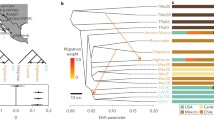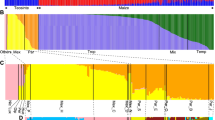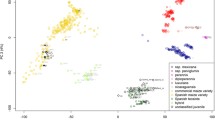Abstract
In this review, the contributions of isozyme and chloroplast DNA studies to questions surrounding the evolution of maize are summarized. These methods of analysis provide generally strong support for the hierarchical system of classification of Zea proposed by Iltis and Doebley (1980). Molecular evidence is fully congruent with the theory that teosinte is ancestral to maize and suggests thatZ. mays subsp.parviglumis was the ancestral teosinte taxon. Further, these data show that only those populations from the central region of the range of subsp. parviglumis resemble maize in both isozymic and chloroplast DNA constitution. Presuming no major changes in the distribution of subsp. parviglumis since the domestication of maize, these data would place the origin of maize in the Balsas River drainage southwest of Mexico City. Molecular systematic evidence provides no support for theories that maize was domesticated independently several times; however, this type of data can not disprove such theories. Analyses of isozyme and chloroplast DNA diversity in Zea provide evidence of limited gene flow between maize and teosinte, but are not consistent with models that postulate extensive genetic interchange between these taxa. Isozyme studies have added substantially to the understanding of evolutionary relationships among extant races of maize and suggest that there are a small number of major racial complexes in Meso- and North America which have often evolved in response to environmental constraints associated with altitude. Ultimately, molecular genetic studies may allow a resolution of the controversy surrounding the morphological evolution of the maize ear.
Similar content being viewed by others
Literature cited
Anderson, E., and H. C. Cutler. 1942. Races ofZea mays: I. Their recognition and classification. Ann. Missouri Bot. Gard. 29:69–88.
Ascherson, P. 1875. UeberEuchlaena mexicana Schrad. Bot. Vereins Prov. Brandenburg 17: 76–80.
—. 1880. Bemerkungen über ä stigen Maiskolben. Bot. Vereins Prov. Brandenburg 21:133–138.
Barrett, S. C. H. 1983. Crop mimicry in weeds. Econ. Bot. 37:255–282.
Beadle, G. W. 1932. Studies ofEuchlaena and its hybrids withZea. I. Chromosome behavior inEuchlaena mexicana and hybrids withZea mays. Z. Indukt. Abstammungsl-Vererbungsl. 62:291–304.
—. 1939.Teosinte and the origin of maize. J. Heredity 30:245–247.
—. 1972. The mystery of maize. Field Mus. Nat. Hist. Bull. 43:2–11.
—. 1980. The ancestry of corn. Sci. Amer. 242:112–119, 162.
Benz, B. 1986. Taxonomy and evolution of Mexican maize. Ph.D. Dissertation, Univ. of Wisconsin, Madison, 446 p.
Benz, B. 1987. Racial systematics and the evolution of Mexican maize. Pages 121–136in L. Manzanilla, ed., Studies in the neolithic and urban revolutions: the V. Gordon Childe Colloquium, Mexico, 1986. B.A.R. International Series 349, Oxford, England.
Bird, R. McK. 1980. Maize evolution from 500 B.C. to the present. Biotropica 12:30–41.
Bretting, P. K., M. M. Goodman, and C. W. Stuber. 1987. Karyological and isozyme variation in West Indian and allied American mainland races of maize. Amer. J. Bot. 74:1601–1613.
-, -, and -. {dy1990}. Isozymatic variation in Guatemalan races of maize. Amer. J. Bot. (in press).
Brown, W. L., and E. Anderson. 1947. The northern flint corns. Ann. Missouri Bot. Gard. 34:1–22.
—, and —. 1948. The southern dent corns. Ann. Missouri Bot. Gard. 35:255–267.
Brown, W. L., and M. M. Goodman. 1977. Races of corn. Pages 49–88in G. F. Sprague, ed., Corn and corn improvement. Amer. Soc. Agronomy, Madison, WI.
Collins, G. N. 1921. Teosinte in Mexico. J. Heredity 12:339–350.
—. 1931. Thephylogeny of maize. Bull. Torrey Bot. Club 57:199–210.
Crawford, D. J. 1983. Phylogenetic and systematic inferences from electrophoretic studies. Pages 257–287in S. D. Tanksley and T. J. Orton, eds., Isozymes in plant genetics and breeding, Part A. Elsevier, Amsterdam.
de Wet, J. M. J., and J. R. Harlan. 1972. Origin of maize: tripartite hypothesis. Euphytica 21:271–279.
Doebley, J. 1983a. The maize and teosinte male inflorescence: a numerical taxonomic study. Ann. Missouri Bot. Gard. 70:32–70.
—. 1983b. The taxonomy and evolution ofTripsacum and teosinte, the closest relatives of maize. Pages 15–28in D. T. Gordon, J. K. Knoke, and L. R. Nault, eds., Proc. intl. maize virus disease colloquium and workshop. The Ohio State University, Ohio Agricultural Research and Development Center, Wooster, OH.
—. 1984. Maize introgression into teosinte—a reappraisal. Ann. Missouri Bot. Gard. 71:1100–1113.
—. 1989. Isozymic evidence and the evolution of crop plants. Pages 165–191in D. Soltis and P. Soltis, eds., Isozymes in plant biology. Dioscorides Press, Portland, OR.
-. 1990. Molecular systematics ofZea (Gramineae). Maydica (in press).
—, M. M. Goodman, and C. W. Stuber. 1983. Isozyme variation in maize from the southwestern United States: taxonomic and anthropological implications. Maydica 28:94–120.
—, —, and —. 1984. Isoenzymatic variation inZea (Gramineae). Syst. Bot. 9:203–218.
—,—, and —. 1985. Isozyme variation in the races of maize from Mexico. Amer. J.Bot. 72:629–639.
—,—, and —. 1986. Exceptional genetic divergence of Northern Flint Corn. Amer. J.Bot. 73:64–69.
—, — and —. 1987a. Patterns of isozyme variation between maize and Mexican annual teosinte. Econ. Bot. 41:234–246.
—, and H. H. Iltis. 1980. Taxonomy ofZea (Gramineae). I. A subgeneric classification with key to taxa. Amer. J. Bot. 67:982–993.
—, W. Renfroe, and A. Blanton. 1987b. Restriction site variation in theZea chloroplast genome.Genetics 117:139–147.
—, and P. Sisco. 1989. On the origin of the maize male sterile cytoplasms: it’s completely unimportant, that's why it's so interesting. Maize Genetics Corporation Newsletter 63:108–109.
—, J. F. Wendel, J. S. C. Smith, C. W. Stuber, and M. M. Goodman. 1988. The origin of cornbelt maize: the isozyme evidence. Econ. Bot. 42:120–131.
Galinat, W. C. 1973. Preserve Guatemalan teosinte, a relict link in corn’s evolution. Science 180: 323.
—. 1983. The origin of maize as shown by key morphological traits of its ancestor, teosinte. Maydica 28:121–138.
—. 1985. The missing links between teosinte and maize: a review. Maydica 30:137–160.
—, and R. G. Campbell. 1967. The diffusion of eight rowed maize from the Southwest to the Central Plains. Mass. Agric. Exp. Sta. Monogr. Ser. 1:1–16.
—, and J. H. Gunnerson. 1963. Spread of eight-rowed maize from the prehistoric Southwest. Bot. Mus. Leafl. 20:117–160.
Goodman, M. M., and C. W. Stuber. 1983a. Maize. Pages 1–33in S. D. Tanksley and T. J. Orton, eds., Isozymes in plant genetics and breeding, Part B. Elsevier, Amsterdam.
—, and —. 1983b. Races of maize. VI. Isozyme variation among races of maize in Bolivia.Maydica 28:169–187.
Guzmán, R. 1978. Una nueva localidad para el teosinteZea perennis y primer reporte deZea mexicana para Jalisco. Bol. Inform. Inst. Bot., Univ. de Guadalajara 6:9–10.
—. 1982. El teosinte en Jalisco: su distribución y ecología. Ingeniera Agronomo Tesis, Escuela de Agriculture, Univ. de Guadalajara, Jalisco, Mexico.
Harshberger, J. W. 1896. Fertile crosses of teosinte and maize. Gard. & Forest 9:522–523.
Heiser, C. 1973. Introgression re-examined. Bot. Rev. (Lancaster) 39:347–366.
Hitchcock, A. S. 1922. A perennial species of teosinte. J. Wash. Acad. Sci. 12:205–208.
Iltis, H. H. 1983. From teosinte to maize: the catastrophic sexual transmutation. Science 222:886–894.
Iltis, H. H.. 1987. Maize evolution and agricultural origins. Pages 195-213in T. Soderstrom, K. Hilu,C. Campbell, and M. Barkworth, eds., Grass systematics and evolution. Smithsonian Inst. Press, Washington, DC.
—, and J. F. Doebley. 1980. Taxonomy of Zea (Gramineae). II. Subspecific categories in theZea mays complex and a generic synopsis. Amer. J. Bot. 67:994–1004.
—, and —. 1984.Zea—a biosystematical Odyssey. Pages 587–616in W. F. Grant, ed., Plant biosystematics. Academic Press, Ontario, Canada.
—,—, R. Guzman, and B. Pazy. 1979.Zea diploperennis (Gramineae): a new teosinte from Mexico. Science 203:186–188.
—, D. A. Kolterman, and B. Benz. 1986. Accurate documentation of germplasm: the lost Guatemalan teosintes (Zea, Gramineae). Econ. Bot. 40:69–77.
Kato, T. A. 1976. Cytological studies of maize. Mass. Agric. Exp. Sta. Res. Bull. No. 635.
— 1984. Chromosome morphology and the origin of maize and its races. Evol. Biol. 17:219–253.
Ladizinsky, G. 1985. Founder effect in crop plant evolution. Econ. Bot. 39:191–199.
Mangelsdorf, P. C. 1974. Corn: its origin, evolution and improvement. Harvard Univ. Press, Cambridge, MA.
—. 1983. The mystery of corn: new perspectives. Proc. Amer. Philos. Soc. 127:215–247.
—. 1986. The origin of corn. Sci. Amer. 254:80–86.
—, and W. C. Galinat. 1964. The tunicate locus in maize dissected and reconstituted. Proc.Natl. Acad. U.S.A. 51:147–150.
-, and R. G. Reeves. 1939. The origin of Indian corn and its relatives. Texas Agric. Exp. Sta. Bull. 574.
McClintock, B. 1959. Chromosome constitutions of Mexican and Guatemalan races of maize. Annual Rep. Dept. Genet. Carnegie Inst. Wash. 59:461–472.
-, T. A. Kato Y., and A. Blumenschein. 1981. Chromosome constitution of races of maize. Colegio de Postgraduados, Chapingo, Mexico.
Montgomery, E. G. 1906. What is an ear of corn? Popular Sci. Monthly 68:55–62.
—. 1913. The corn crops. MacMillan, New York.
Nei, M. 1972. Genetic distance between populations. Amer. Naturalist 106:283–292.
Randolph, L. F. 1959. The origin of maize. Indian J. Genet. PL Breed. 19:1–12.
Reeves, R. G., and P. C. Mangelsdorf. 1942. A proposed taxonomic change in the tribe Maydeae (family Gramineae). Amer. J. Bot. 29:815–817.
Rick, C, R. W. Zobel, and J. F. Fobes. 1974. Four peroxidase loci in red-fruited tomato species: genetics and geographic distribution. Proc. Natl. Acad. U.S.A. 71:835–839.
Saint-Hilaire, A. de. 1829. Lettre sur une variété remarquable de maïs du Brésil. Ann. Sci. Nat.(Paris) 16:143–145.
Sanchez G., J., and L. Ordaz S. 1987. El teosinte en México: distribución actual de las poblaciones. International Board for Plant Genetics Resources, Systematic and Ecogeographic Studies on Crop Genepools No. 2.
Schrader, H. 1833. In Litteratur. Linnaea (Berlin) 1833:25–26.
Smith, J. S. C., M. M. Goodman, and C. W. Stuber. 1984. Variation within teosinte. III. Numerical analysis of allozyme data. Econ. Bot. 38:97–113.
—, —, and —. 1985. Relationships between maize and teosinte of Mexico and Guatemala:numerical analysis of allozyme data. Econ. Bot. 39:12–24.
Stuber, C. W., and M. M. Goodman. 1983. Allozyme genotypes for popular and historically important inbred lines of corn,Zea mays L. USDA Agric. Res. Results, Southern Series 16, New Orleans, LA.
Sturtevant, E. L. 1899. Varieties of corn. U.S.D.A. Off. Exp. Sta. Bull. No. 57.
Sundberg, M. D. 1987. Development of the mixed inflorescences inZea diploperennis Iltis, Doebley and Guzman (Poaceae). J. Linn. Soc, Bot. 95:207–216.
—, and A. R. Orr. 1986. Early inflorescence and floral development inZea diploperennis, diploperennial teosinte. Amer. J. Bot. 73:1699–1712.
Timothy, D. H., C. S. Levings, D. R. Pring, M. F. Conde, and J. L. Kermicle. 1979. Organelle DNA variation and systematic relationships in the genusZea: teosinte. Proc. Natl. Acad. U.S.A. 76:4220–4224.
von Post, T., and O. Kuntze. 1904. Lexicon generum phanerogamarum. Deutsche Verlags-Anstalt, Stuttgart.
Wallace, H. A., and W. L. Brown. 1956. Corn and its early fathers. Michigan State Univ. Press, East Lansing, MI.
Weatherwax, P. 1935. The phytogeny ofZea mays. Amer. Midi. Naturalist 16:1–71.
Weissinger, A. K., D. H. Timothy, C. S. Levings III, and M. M. Goodman. 1983. Patterns of mitochondrial DNA variation in indigenous maize races of Latin America. Genetics 104:365–379.
Wellhausen, E. J., A. Fuentes O., and A. Hernández C. (in collaboration with P. C. Mangelsdorf). 1957. Races of maize in Central America. Natl. Res. Council Publ. 511.
—, L. M. Roberts, and E. Hernández X. (in collaboration with P. C. Mangelsdorf). 1952. Races of maize in Mexico. Bussey Inst, Harvard Univ., Cambridge, MA.
Wilkes, H. G. 1967. Teosinte: the closest relative of maize. Bussey Inst., Harvard Univ., Cambridge, MA.
—. 1970. Teosinte introgression in the maize of the Nobogame valley. Bot. Mus. Leafl. 22:297–311.
—. 1977. Hybridization of maize and teosinte in Mexico and Guatemala and the improvement of maize. Econ. Bot. 31:254–293.
Author information
Authors and Affiliations
Rights and permissions
About this article
Cite this article
Doebley, J. Molecular Evidence and the Evolution of Maize. Econ Bot 44 (Suppl 3), 6–27 (1990). https://doi.org/10.1007/BF02860472
Issue Date:
DOI: https://doi.org/10.1007/BF02860472




